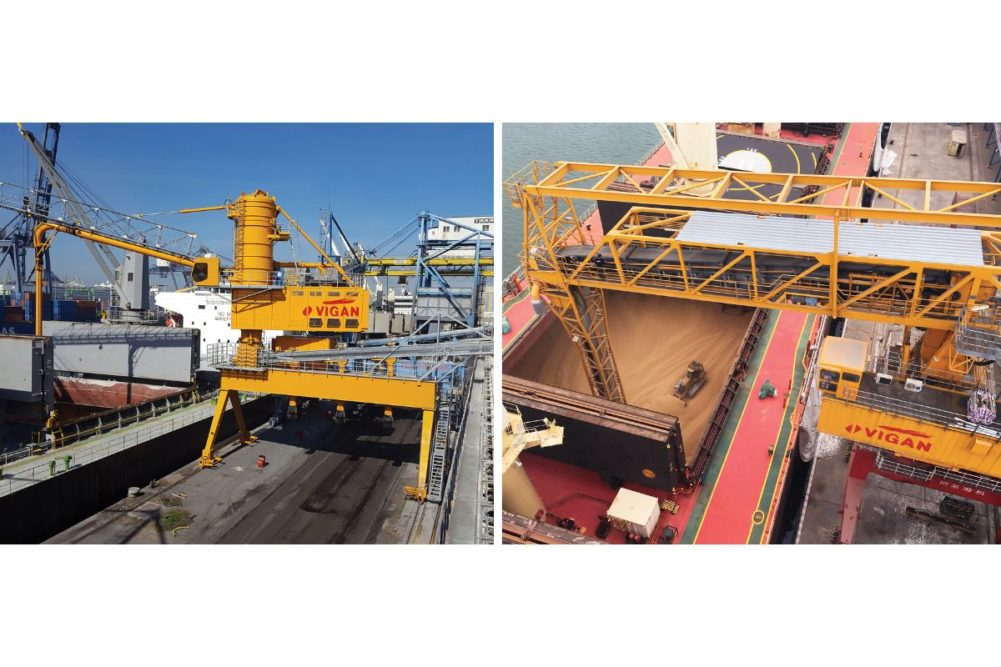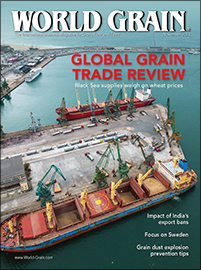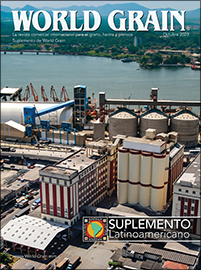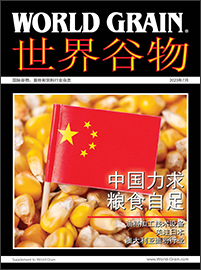KANSAS CITY, MISSOURI, US — When it comes to choosing the type of ship unloader to use at a port facility that handles grain, there are many factors to consider.
It basically boils down to two types of equipment: mechanical vs. pneumatic ship unloaders. Each has advantages and disadvantages.
World Grain recently asked Nicholas Dechamps, managing director of Belgium-based Vigan Inc., to give his thoughts on the subject.
WG: What are the pros and cons of mechanical ship unloaders?
Dechamps: Let me first step back and comment on the question itself. Most ship unloading companies are offering either mechanical or pneumatic. Therefore, too often, people are opposing these technologies. And most suppliers are naturally trying to push the type of equipment they can do. Although Vigan is well-known worldwide for its pneumatic unloaders, it acquired the Simporter/double belt mechanical technology 15 years ago. Vigan is the only supplier offering both technologies. Each has indeed pros and cons. The idea is not to try to convince the terminal operators about the technology we have, but to offer the technology that is best for them. For large import grain terminals, Vigan believes that a combination of a mechanical and a pneumatic unloader makes a lot of sense. We should stop seeing these technologies as purely competitors, as they may be complementary. In summary, mechanical ship unloaders are recognized as very good unloaders with:
Pros:
- High speed and capacity: Mechanical ship unloaders boast impressive capacities. They are competitive in the range from 800 to 1,200-1,500 tonnes per hour (tph).
- One of the notable advantages of mechanical ship unloaders is their relatively lower energy consumption when operating at high capacity.
Cons:
- Lower overall efficiency: Despite their impressive speed, mechanical unloaders often struggle with efficiency, especially when handling the last layer of cargo within a ship’s hold, the so-called clean-up phase.
- Maintenance profile: Due to the presence of moving parts, mechanical ship unloaders can have sudden failure/breakage, leading to a shutdown of operations.
- Higher initial investment.
WG: What are the pros and cons of pneumatic ship unloaders?
Dechamps: Pneumatic ship unloaders are more and more popular. Overall, pneumatic unloaders are undoubtedly gaining market share. Their characteristics are:
Pros:
- High efficiency: Pneumatic ship unloaders excel in efficiency. Their unique suction-based design ensures that no grain remains in the hold, resulting in quicker “berth in-berth out” turnaround. What’s the point of the high nominal capacity of a mechanical unloader if the average capacity is only 55%-60%?
- Cost-effective investment: Pneumatic unloaders typically come with lower upfront costs, as it is a lighter /simpler equipment.
- Spare parts costs: A pneumatic unloader is a pipe with vacuum fans in the machine room. There are no moving parts above the water and maintenance is easy. Pneumatic unloaders can suffer from progressive wear, but not from breakage or stoppages.
Cons:
- Power Consumption: Pneumatic unloaders have made strides in reducing their power consumption, with some models achieving energy usage as low as 0.7 kWh/t, barely above the mechanical average consumption.
- Lower unloading capacity: Typical pneumatic unloaders were between 200 and 600 tph capacity. In the last couple of years, Vigan launched its NIV 800. Compared to mechanical unloaders, this lower nominal capacity is balanced by a higher 75% to 80% efficiency.
WG: What new features have been added to pneumatic and mechanical ship unloaders in recent years?
Dechamps: Both pneumatic and mechanical ship unloaders have undergone significant advancements. For suppliers and port operators, the first priority of any R&D remains focused on the reliability. In front of a vessel costing huge demurrages, a ship unloader cannot fail.
Other notable developments include:
- Optional devices: Both types of unloaders can now be equipped with optional accessories, such as cutting nozzles or screw equipment, to facilitate cargo fluidization, ensuring efficient unloading of difficult cargoes such as soyabean meal and DDGS.
- Power consumption reduction: Pneumatic unloaders have successfully reduced their power consumption by employing multi-stage turbo blowers and inverter technology, allowing for automatic power regulation based on demand.
- Noise and dust reduction features.
- Electronics and automation while keeping in mind that the 40-year lifetime of a ship unloader is 10 times the lifetime of a computer.
WG: How do they compare in terms of cost and return on investment?
Dechamps: For grain, seeds, wood pellets, alumina, and the like, the market is moving year after year toward pneumatic unloaders. Pneumatic unloaders are cheaper, easier to operate, and feature higher efficiency. There are not many operators having the yearly unloading volume that can justify a mechanical unloader.
WG: How much have unloading capacities increased in recent years?
Dechamps: The unloading capacity cannot be higher than the handling capacity of the elevator of the silo. There is no point to increase the unloading if the silo cannot handle it. Mechanical unloaders are peaking around 1,500 tph, while the pneumatic’s most popular range is now 600 and 800 tph.
WG: How long are the average lifespans of each of these types of unloaders?
Dechamps: I smile when you asked me that question. Both mechanical and pneumatic unloaders are extremely reliable equipment, lasting 30 to 40 years, no problem. Those from Vigan and also those from our competitors. I think I will never see the end of one unloader that Vigan has manufactured since I joined Vigan in 2003.
WG: Do you have any new features that you are working on that will improve your ship unloading equipment?
Dechamps: Vigan Engineering is continuously innovating to provide top-performing equipment in the market, particularly in the field of ship loaders and unloaders. For instance, we offer authentic multi-stage turbines, turbulence-free circular elbows engineered to handle millions of tonnes, and airlocks featuring a sealing adjustment system. We are at the forefront of technological advancements within our sector, exemplified by our pioneering use of variable speed drive technology in suction units, especially in the area of energy consumption. Our philosophy is straightforward: we prioritize functionality over unnecessary “gadget” add-ons. Our machines are likely the most efficient available, owing to their well-thought-out design and exceptionally low maintenance and operational costs. We often receive inquiries from grain handlers whose port facilities are situated in urban areas, expressing concerns about the noise generated by our equipment. A machine’s noise profile can be quite monotonous, but it may also exhibit variations in sound, particularly when certain components like valves or pistons are engaged. In such instances, we undertake in-house acoustic calculations to pinpoint the sources of noise and work toward achieving an acceptable noise level.





